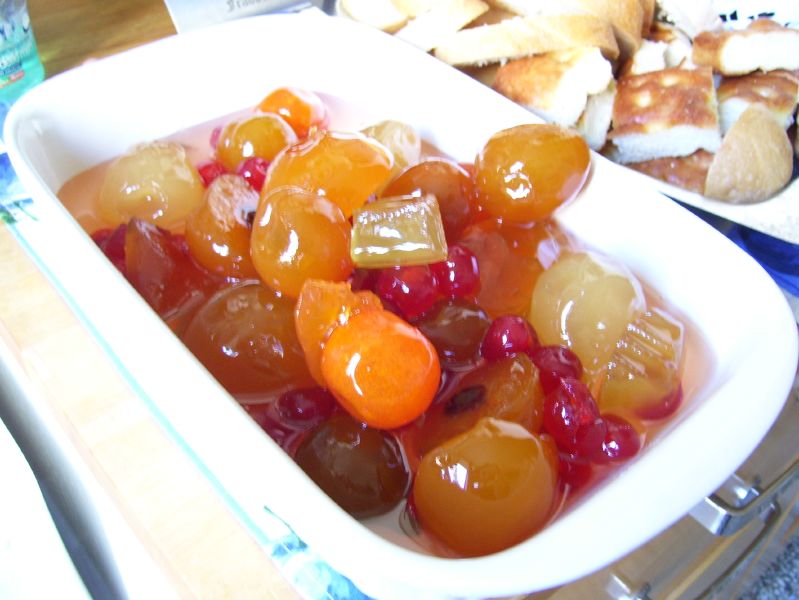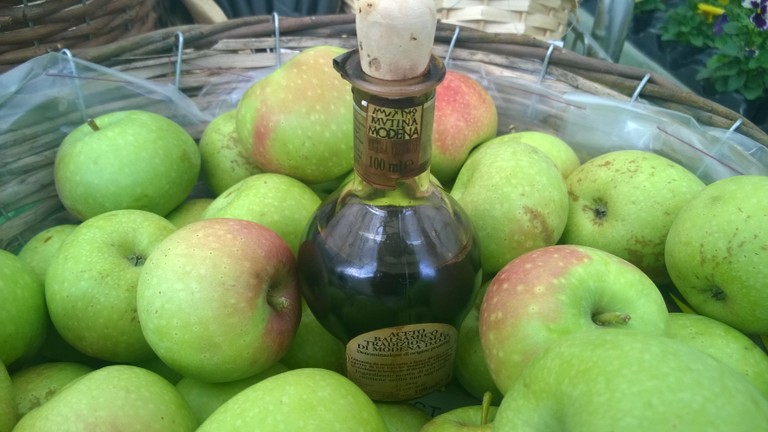|
Mostarda
''Mostarda di frutta '' (sometime also called ''mostarda'') is a Northern Italian condiment made of candied fruit and a mustard-flavoured syrup. Commercially the essential oil of mustard is employed, which has the advantage of transparency; in home cooking, mustard powder heated in white wine may be used. Traditionally was served with boiled meats, the which is a speciality of northern Italian cooking. More recently it has become a popular accompaniment to cheeses. Variations or (from Cremona) is made with several kinds of fruit, and is the version that typifies . (also called or ) is made from small, sour green apples called . Another notable is , which is a specialty of the town of Vicenza (Veneto); it is characterized by a jam-like consistency and the use of quince () as its main ingredient. Other versions include , , and . See also * List of mustard brands * Specialty foods A specialty food is a food that is typically considered as a "unique and high-value ... [...More Info...] [...Related Items...] OR: [Wikipedia] [Google] [Baidu] |
Mustard (condiment)
Mustard is a condiment made from the mustard seed, seeds of a mustard plant (white/yellow mustard, ''white mustard, Sinapis alba''; brown mustard, ''Brassica juncea''; or black mustard, ''Brassica nigra''). The whole, ground, cracked, or bruised mustard seeds are mixed with water, vinegar, lemon juice, wine, or other liquids, salt, and often other flavorings and spices, to create a paste or sauce ranging in color from bright yellow to dark brown. The seed itself has a strong, pungent, and somewhat bitter taste. The taste of mustard condiments ranges from sweet to spicy. Mustard is commonly paired with meats, vegetables and cheeses, especially as a condiment for sandwiches, hamburgers, and hot dogs. It is also used as an ingredient in many salad dressing, dressings, Glaze (cooking technique), glazes, sauces, soups, and marinades. As a cream or as individual seeds, mustard is used as a condiment in the cuisine of Indian cuisine, India and Bangladeshi cuisine, Bangladesh, the Medi ... [...More Info...] [...Related Items...] OR: [Wikipedia] [Google] [Baidu] |
Campanino
Campanino ( it, mela campanina; in the Emilian dialect Mirandolese , ), also known as , , or , , is a variety of the domestic apple. Thanks to its long shelf life, the has been popular not only in Italy but also in export to countries such as Germany. Campanino apples are included in the list of Italian Traditional Foodstuffs ( – PAT) from the Emilia-Romagna region, and in the Emilia-Romagna Regional Voluntary Database of Agricultural Genetic Resources (code RER V019). The ''cultivar'' is also widespread in the Veneto region, where it is called ''campanìn'' (code GM27) or ''Modena apple'' (code GM47). History The ancient origins of this variety are not known. An early reference was in 1751 when Francesco Argelati from Bologna described the character of Bartolomea Gualandi as In 1815, Italian pomologist Georges Gallesio described a seedling found in the province of Modena as "Modena apple". In 1877 historian Don Felice Ceretti from Mirandola, published an article in ... [...More Info...] [...Related Items...] OR: [Wikipedia] [Google] [Baidu] |
Specialty Foods
A specialty food is a food that is typically considered as a "unique and high-value food item made in small quantities from high-quality ingredients". Consumers typically pay higher prices for specialty foods, and may perceive them as having various benefits compared to non-specialty foods. Compared to staple foods, specialty foods may have higher prices due to more expensive ingredients and labor. Some food stores specialize in or predominantly purvey specialty foods. Several organizations exist that promote specialty foods and its purveyors. Definition There is no standard definition for "specialty food". Specialty foods Foods that have been described as specialty foods include: * Alici from the Gulf of Trieste near Barcola. * Artisanal foods. * Caviar. * Cheese and artisan cheese. * Specialty coffee – sometimes referred to as artisanal coffee. * High-quality chocolate. * Foie gras. * Iberico, Serrano, and other artisanal Dry-cured ham. * Morel, Chanterelle, Matsutake an ... [...More Info...] [...Related Items...] OR: [Wikipedia] [Google] [Baidu] |
Bollito Misto
Bollito misto (, literally "mixed boil" or "mixed boiled meat") is a classic northern Italian stew, most closely resembling the French Pot-au-feu, consisting of various tougher cuts of beef and veal, cotechino, and a whole hen or capon that are gently simmered for 2–3 hours in an aromatic vegetable broth. Bollito and its many regional variations is eaten throughout northern Italy, and is particularly popular in Emilia-Romagna, Piedmont, and Lombardy. The meat is sliced thinly and served with coarse sea salt, mostarda, salsa verde, horseradish, or chutney. The resulting broth is skimmed, strained, and used as a base for soups and risottos. History In Italian cuisine, bollito was prominent throughout the second millennium. In the 1800s, crown prince and from 1849 king Vittorio Emanuele II would often sneak off to the small town of Moncalvo to hunt wild game, cavort with his favorite mistress, and enjoy a convivial meal of bollito with friends. Bollito features prominently in ... [...More Info...] [...Related Items...] OR: [Wikipedia] [Google] [Baidu] |
Cremona
Cremona (, also ; ; lmo, label= Cremunés, Cremùna; egl, Carmona) is a city and ''comune'' in northern Italy, situated in Lombardy, on the left bank of the Po river in the middle of the ''Pianura Padana'' ( Po Valley). It is the capital of the province of Cremona and the seat of the local city and province governments. The city of Cremona is especially noted for its musical history and traditions, including some of the earliest and most renowned luthiers, such as Giuseppe Guarneri, Antonio Stradivari, Francesco Rugeri, Vincenzo Rugeri, and several members of the Amati family. History Ancient Celtic origin Cremona is first mentioned in history as a settlement of the Cenomani, a Gallic ( Celtic) tribe that arrived in the Po valley around 400 BC. However, the name Cremona most likely dates back to earlier settlers and puzzled the ancients, who gave many fanciful interpretations. Roman military outpost In 218 BC the Romans established on that spot their first military outpo ... [...More Info...] [...Related Items...] OR: [Wikipedia] [Google] [Baidu] |
Quince
The quince (; ''Cydonia oblonga'') is the sole member of the genus ''Cydonia'' in the Malinae subtribe (which also contains apples and pears, among other fruits) of the Rosaceae family (biology), family. It is a deciduous tree that bears hard, aromatic bright golden-yellow pome fruit, similar in appearance to a pear. Ripe quince fruits are hard, tart, and astringent. They are seldom eaten raw, but are processed into marmalade, jam, paste (known as quince cheese) or alcoholic beverages. The quince tree is also grown as an ornamental plant for its attractive pale pink blossoms and other ornamental qualities. Description The tree grows high and wide. The fruit is long and across. The immature fruit is green with dense grey-white fine hair, most of which rubs off before maturity in late autumn when the fruit changes colour to yellow with hard, strongly perfumed flesh. The leaf, leaves are alternately arranged, simple, long, with an entire margin and densely pubescent with ... [...More Info...] [...Related Items...] OR: [Wikipedia] [Google] [Baidu] |
Italian Cuisine
Italian cuisine (, ) is a Mediterranean cuisine#CITEREFDavid1988, David 1988, Introduction, pp.101–103 consisting of the ingredients, recipes and List of cooking techniques, cooking techniques developed across the Italian Peninsula and later spread around the world together with waves of Italian diaspora. Some of these foods were imported from other cultures. Significant changes Columbian Exchange, occurred with the colonization of the Americas and the introduction of potatoes, tomatoes, capsicums, maize and sugar beet — the latter introduced in quantity in the 18th century. It is one of the best-known and most appreciated Gastronomy, gastronomies worldwide. Italian cuisine includes deeply rooted traditions common to the whole country, as well as all the Regional cuisine, regional gastronomies, different from each other, especially between Northern Italy, the north, Central Italy, the centre and Southern Italy, the south of Italy, which are in continuous exchange. Many di ... [...More Info...] [...Related Items...] OR: [Wikipedia] [Google] [Baidu] |
List Of Mustard Brands
Mustard (condiment), Mustard is a condiment made from the mustard seeds from one of three varieties of mustard plant: white mustard, ''Sinapis alba'', white mustard (also known as yellow mustard); ''Brassica juncea'', brown mustard; or ''Brassica nigra'', black mustard. The whole, ground, cracked, or bruised mustard seeds are mixed with water, vinegar, or other liquids, and sometimes other flavorings and spices, to create a paste or sauce ranging in color from bright yellow to dark brown. Mustard brands A *Amora (mustard), Amora is a French company most known for its Dijon mustard. It is based in Dijon. Amora is currently a subsidiary of Unilever. B *Bertman Original Ballpark Mustard created by Joe Bertman in Cleveland is a spicy brown mustard used for more than 90 years at sports stadiums in the Cleveland, Ohio, area and is also sold at retail. *Boar's Head Provision Company, Boar's Head produces a delicatessen-style mustard from an old German recipe that combines white wine an ... [...More Info...] [...Related Items...] OR: [Wikipedia] [Google] [Baidu] |
Elizabeth David
Elizabeth David CBE (born Elizabeth Gwynne, 26 December 1913 – 22 May 1992) was a British cookery writer. In the mid-20th century she strongly influenced the revitalisation of home cookery in her native country and beyond with articles and books about European cuisines and traditional British dishes. Born to an upper-class family, David rebelled against social norms of the day. In the 1930s she studied art in Paris, became an actress, and ran off with a married man with whom she sailed in a small boat to Italy, where their boat was confiscated. They reached Greece, where they were nearly trapped by the German invasion in 1941, but escaped to Egypt, where they parted. She then worked for the British government, running a library in Cairo. While there she married, but she and her husband separated soon after and subsequently divorced. In 1946 David returned to England, where food rationing imposed during the Second World War remained in force. Dismayed by the contrast betwee ... [...More Info...] [...Related Items...] OR: [Wikipedia] [Google] [Baidu] |
Veneto
Veneto (, ; vec, Vèneto ) or Venetia is one of the 20 regions of Italy. Its population is about five million, ranking fourth in Italy. The region's capital is Venice while the biggest city is Verona. Veneto was part of the Roman Empire until the 5th century AD. Later, after a Feudalism, feudal period, it was part of the Republic of Venice until 1797. Venice ruled for centuries over one of the largest and richest maritime republics and trade empires in the world. After the Napoleonic Wars and the Congress of Vienna, the Republic was combined with Lombardy and annexed to the Austrian Empire as the Kingdom of Lombardy–Venetia, until that was Italian unification, merged with the Kingdom of Italy in 1866, as a result of the Third Italian War of Independence. Besides Italian language, Italian, most inhabitants also speak Venetian language, Venetian. Since 1971, the Statute of Veneto has referred to the region's citizens as "the Venetian people". Article 1 defines Veneto as an " ... [...More Info...] [...Related Items...] OR: [Wikipedia] [Google] [Baidu] |





.jpg)



